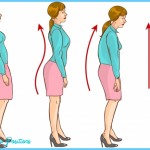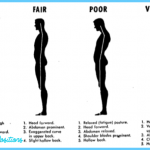Many of us strut in way-too-high heels, resulting in a walk with a sway that’s not OK (like a praying mantis on hot coals). By doing that we’re placing our spines under immense pressure, throwing everything off and weakening the core. And who isn’t slouching, facing laptops for hours on end daily? Almost all of us. But there is a bigger baddie impacting our posture: stress. Poor posture, linked to joint pain, headaches and fatigue (hello, big yawns at your work desk), has also been linked to depression and how others perceive your confi dence. On a mission to beat the stress slump and take control of my posture, I head to The Health and Wellness Centre in Bryanston to fi nd ways to develop and maintain better posture with Samantha Quigley, a Body Stress Release (BSR) practitioner. She leads me to an upright table not too dissimilar to a massage bed.
What Is Posture? | Good Posture | Bad Posture Photo Gallery
Standing in front of it with my arms at my side, I place my face in a little hole and then she lowers me and the bed down, where she begins by applying gentle pressure as part of the body stress test. ‘With our technique, we want to try to release stress from your body in a mechanical way by working with the direction of the pull of the muscles, so it’s physiologically sound,’ says Quigley, who adds that BSR is a natural therapy that works with the physicality of stress. ‘We do bio-feedback testing, which indicates what’s going on in your body, what you have been through in life and how you’ve manifested mechanical and emotional stress. The bio-feedback response allows us to be client-specific. If you stop the muscles from pulling, you get better blood supply, better nerve supply and ultimately better function to feel better in your body.’ Thinking back to my teen years, my posture was awkward. I was constantly slouching due to the shyness of being taller than most of my class mates.
I ask Quigley if there’s a link between posture and confidence. ‘Absolutely,’ she says. ‘Think about your posture when sitting at work, you are hunched over and there’s no openness to you and the chest area. You end up closing yourself off. If you’re sitting upright you’re more approachable. Your body has to feel the same response on a cellular level – you feel happier and that comes with deeper breathing, it’s more peaceful and calm.’ I’m amazed at how gentle, yet effective the technique is, feeling ultra-tender spots with not much pressure at all. ‘As the mechanics are applied, often emotions that are stored release, but it’s different for everybody,’ she notes. Visions of the past few stressful months play in my mind, and as my session, which is 30 minutes long, draws to a close, I feel exhausted and a little spaced out.
It’s recommended that you schedule three sessions upfront, and then decide how you wish to proceed and, as I schedule my second appointment, Quigley recommends drinking lots of water. What she doesn’t tell me is how emotional I’ll feel after the session (wanting to cry and in a bad mood for most of the weekend), although I sleep well that evening. The second appointment rolls around. This time, Quigley is working on areas she had not touched on in my first session, but this time, I don’t feel as tender, although I can definitely feel where she had worked on me a few days ago. I leave this session feeling less emotional and my mood is lighter, realising how much tension and stress I must have stored up and have now released. It’s enough to make me more conscious of how I sit, how I position my body on the chair, and pay attention when my shoulders droop and stomach juts out. When in traffic, I make a point of sitting up straight with my spine aligned flat against my seat, breathing deeply to feel calmer. The only thing left to do is strengthen my core, and for me it’s all about making time for yoga and possibly fitting in a few sessions of Pilates for added benefit.








